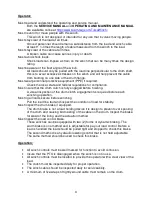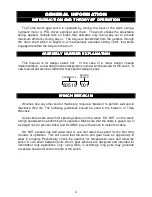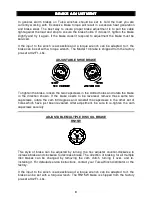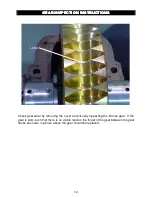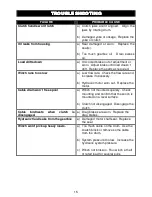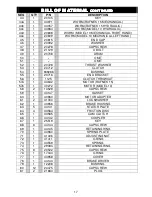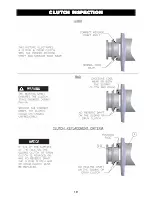
11
CLUTCH AND DRUM DISASSEMBLY
CLUTCH AND DRUM DISASSEMBLY
CLUTCH AND DRUM DISASSEMBLY
CLUTCH AND DRUM DISASSEMBLY
1. Remove the capscrews (34), nuts
(31), and washers (32) attaching the
end bracket (55) to the frames (29 &
30).
2. Remove the end bracket (55), clutch
throwout assembly (56), and sliding
clutch (53).
3. Remove the keys (38) and thrust
washer (52) from the output shaft
(37).
4. Slide the drum (49) off of the output
shaft (37), making sure to keep the
weight of the drum supported.
5. Inspect parts as follows, replace if
necessary:
A. Inspect the bushing (54) in the
end bracket (55) for excessive
wear.
B. Inspect the keys (38), sliding
clutch (53), and thrust washer
(52) for damage. See page 17
for clutch inspection.
C. Inspect the bores of the drum
(49) for any wear or damage.
GEAR
GEAR
GEAR
GEARBOX
BOX
BOX
BOX D
D
D
DIS
IS
IS
ISA
A
A
ASSEMBLY
SSEMBLY
SSEMBLY
SSEMBLY
1. Supporting the end of the output
shaft (37) with a hoist, remove the
cover (26) by removing capscrews
(24 and 25), nuts (12), and washers
(13).
2. Use the hoist to lift the output shaft
(37), bushings (21), keys (36), roll
pin (41), and gear (assembled items
12, 13, 28, 35, and 40) out of the
housing (39).
3. Remove the bushings (21) from the
output shaft (37). Remove the gear
(28) from the carrier (40) by
removing the twelve capscrews (35),
nuts (12), and washers (13).
4. Remove the carrier (40) by removing
the roll pin (41) then remove the keys
(36).
5. Remove the worm (44) from the
housing (39) by removing either the
motor (57) and motor adapter (60),
or the end cap (45), depending on
the type of drive. From the brake
end, push the worm (44) out of the
housing (39). If the brake has not
been removed, see the brake
disassembly on page eight or nine.
6. Inspect parts as follows, replace if
necessary:
A. Inspect the carrier (40) for
damage.
B.
Inspect
the
gear
(28)
for
excessive wear or damage.
See
Pg.12
this
manual
for
detailed
instructions.
C. Inspect the keys (36) for damage.
D. Inspect the bushings (21) for
excessive wear.
E. Inspect
the
worm
(44)
for
excessive wear or signs of heat
checking or cracks.
F. Inspect the bearings (20) and
seals (19) for excessive wear or
damage.



